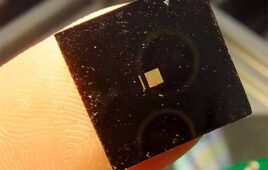
[Image from Rice University]
Rice University researchers suggest that the implant technique could improve therapies that need electrodes to sense neuronal signals and set off actions in patients who have epilepsy and other conditions. They also suggest that nanotube-based electrodes could help researchers and scientists figure out the mechanisms behind cognitive processes which can help patients see, hear and control artificial limbs.
The device uses the force created by fast-moving fluids to gently push insulated flexible fibers into brain tissue without the fibers bending. The method could help replace traditional hard shuttles and stiff, biodegradable sheaths that deliver wires to the brain, which can cause damage to sensitive tissue during the process.
In vivo experiments show that the microfluidic device is able to force a viscous fluid to flow around thin fiber electrodes. The fast-moving fluid pulls the fiber through a small hole that leads to the tissue. The wire stays completely straight once it crosses into the tissue, despite it being highly flexible.
“The electrode is like a cooked noodle that you’re trying to put into a bowl of Jell-O,” Rice engineer Jacob Robinson, one of the project leaders, said in a press release. “By itself, it doesn’t work. But if you put that noodle under running water, the water pulls the noodle straight.”
Even though the fluids move quickly, the wire moves slowly. The researchers say it is easier to pull something flexible than it is to push it.
“The important thing is we’re not pushing on the end of the wire or at an individual location,” said Caleb Kemere, a Rice electrical and computer engineer who specializes in neuroscience. “We’re pulling along the whole cross-section of the electrode and the force is completely distributed.”
The hole that the fiber moves through is three times the size of the fiber. However, it is still small enough to let a small amount of the fluid through. The fluid doesn’t follow the wire into the brain tissue, according to the researchers. A small gap between the device and tissue allows the small fiber to stay on course.
“We use this very short, unsupported length to allow us to penetrate into the brain and use the fluid flow on the back end to keep the electrode stiff as we move it down into the tissue,” Robinson said.
Carbon nanotube fibers conduct electrons in all directions, but they can only be conductive at the tip if they want to communicate with neurons.
“We take insulation for granted. But coating a nanotube thread with something that will maintain its integrity and block ions from coming in along the side is nontrivial,” Kemere said.
One of the researchers developed a coating method to coat the carbon nanotube fiber and be able to keep it between 15 to 30 microns wide, which is smaller than the width of human hair.
“Once we knew the size of the fiber, we fabricated the device to match it,” Robinson said. “It turned out we could make the exit channel two or three times the diameter of the electrode without having a lot of fluid come through.”
The researchers hope to make their technology small enough to deliver multiple micro electrodes that are closely packed into the brain to make implants safer and easier to embed.
The research was published in the journal Nano Letters and was supported by the Defense Advanced Research Project Agency, the Welch Foundation, the National Science Foundation, the Air Force Office of Scientific Research, the American Heart Association, the National Institutes of Health and the Citizens United for Research in Epilepsy Taking Flight Award.




